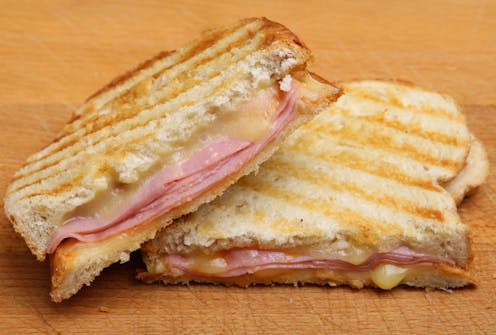Why ban ham from school canteens? And what are some healthier alternatives for kids’ lunches?
- Written by Lauren Ball, Professor of Community Health and Wellbeing, The University of Queensland

Western Australia has introduced a limit on ham in school canteens. Parents are reportedly confused and frustrated. So what has changed and what evidence is it based on?
Reclassifying processed meats
The WA Department of Health has reconfigured its system for classifying food and drink in public schools. It uses a traffic light approach, allocating green, amber or red colours to foods and drinks.
Ham and other processed red meats have been moved from an “amber” label to a “red” label.
Read more: Yes, we still need to cut down on red and processed meat
Each colour is associated with restrictions on how food and drinks can be sold:
- green items must account for at least 60% of items on a menu
- amber items must account for less than 40% of items on a menu
- red items cannot be on the menu.
There’s one catch. The new guidelines allow ham to be sold as if it is an amber item, only two days per week, if ham was already on a canteen’s menu prior to the reconfiguration.
Why restrict ham?
Singling out nutrients or foods as “good” or “bad” can lead to confusion and polarised views on diet. Rather than focusing on individual foods, long-term health outcomes are more closely linked to overall dietary patterns.
Ham itself is not inherently considered junk food. It’s a source of protein and many other nutrients.
However, certain types of ham products – especially highly processed or cured hams – are less healthy options for several reasons:
High sodium content
Many commercially available hams, especially highly processed and cured varieties, can be high in sodium, which is salt.
Excessive sodium intake is associated with health issues such as high blood pressure and can increase the risk of heart disease and strokes.
On average, Australian children consume more sodium than the recommended upper limit: 600 mg a day for children aged four to eight and 800 mg a day for those aged nine to 13.
The World Health Organization says reducing sodium is one of the most cost-effective ways nations can improve the health of their populations.
Read more: Health Check: how much salt is OK to eat?
Additives
Some processed hams may contain additives, preservatives and flavour-enhancers we should limit.
Saturated fat
While ham is a good source of protein, certain cuts can be higher in saturated fat.
Any ham sold in canteens under the new rules (where ham is treated as an “amber” food until the canteen menu changes) must have less than 3g of saturated fat per 100g.
Diets high in saturated fat are linked to an increased risk of heart disease. However, not all research supports this claim.
Processing methods
The methods to process and cure ham may involve smoking, which can produce compounds such as polycyclic aromatic hydrocarbons. In large quantities, these may cause health concerns, including increasing the risk of bowel cancer.
What are some ham alternatives?
Lean, minimally processed ham, prepared without excessive sodium or additives, can potentially be a part of a healthy overall diet. And parents in WA can continue packing ham in their child’s lunchbox.
When choosing ham, read the labels and select products with a lower sodium content, minimal additives and healthier preparation methods.
When looking for low-salt alternatives to ham, there are several options to consider:
turkey breast. Turkey is a lean meat and can be a good substitute for ham. Look for low-sodium or no-salt-added varieties
chicken breast. Skinless, boneless chicken breast is a versatile and low-sodium option. Grilling, baking or roasting can add flavour without relying on salt
smoked salmon. While salmon naturally contains some sodium, smoked salmon tends to be lower in sodium than cured ham. Choose varieties with little or no added salt
roast beef. Choose lean cuts of roast beef and consider seasoning with herbs and spices instead of relying on salt for flavour
homemade roasts. Prepare your own roasts using lean meats such as pork loin, beef sirloin or lamb. This way, you have more control over the ingredients and can minimise added salt
grilled vegetables. These can be a tasty alternative to meat. Eggplant, zucchini, capsicum and portobello mushrooms have a satisfying texture and flavour
beans and legumes. Beans, lentils and chickpeas can be used as alternatives in various dishes. They are naturally low in sodium and high in protein and fibre.
What are some other lunchbox tips?
Packing lunchboxes can be challenging and frustrating for parents.
Consider planning ahead, involving your kids, reducing pre-packaged foods, balancing cost and convenience, and giving your kids lunchbox accountability.
Many websites provide ideas for parents, including websites focused on low-cost foods.
Read more: Sick of packing school lunches already? Here's how to make it easier
Remember to keep portions appropriate for kids and to consider any allergies or school regulations when packing lunches.
Making the lunch experience interactive and enjoyable can encourage kids to embrace healthier eating habits.
Authors: Lauren Ball, Professor of Community Health and Wellbeing, The University of Queensland





